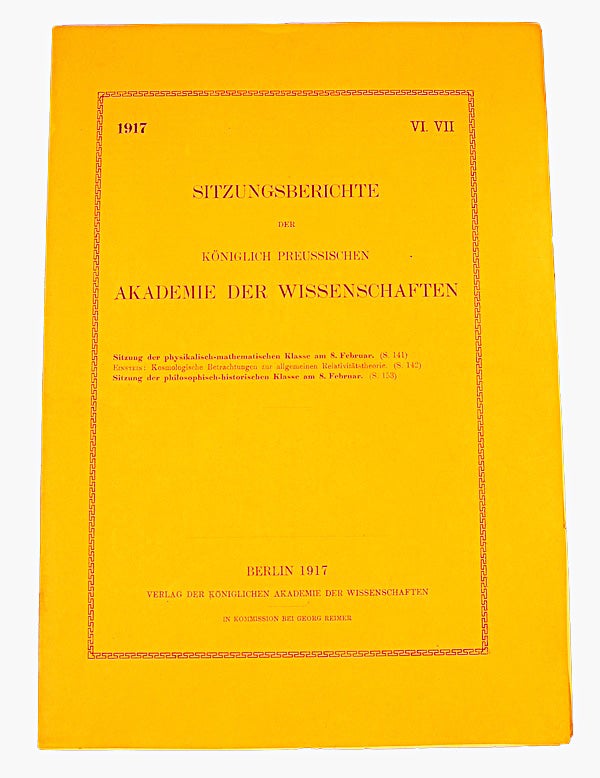Kosmologische Betrachtungen zur Allgemeinen Relativitätstheorie
In February 1917, Einstein “submitted a paper which once again marks the beginning of a new chapter in physics: general relativistic cosmology.” (Pais).
“This suggestion of a finite but unbounded space is one of the greatest ideas about the nature of the worlds which has ever been conceived.” –Max Born
FIRST PRINTING IN ORIGINAL WRAPPERS of Einstein’s famous “cosmological constant paper”, providing others with the theoretical foundation for the notion of an expanding universe.
“The issue of inertia got Einstein into a debate with one of the great astronomers of the time, Willem de Sitter of Leiden. Throughout 1916, Einstein struggled to preserve the relativity of inertia and Mach’s principle by using all sorts of constructs, including assuming various ‘border conditions’ such as distant masses along the fringes of space that were, by necessity, unable to be observed...
“By February 1917, Einstein had come up with a new approach... It was an idea that initially struck him as so wacky that he told his friend Paul Ehrenfest in Leiden, ‘It exposes me to the danger of being confined to a madhouse.’...
“His new idea was published that month in what became yet another seminal Einstein paper, ‘Cosmological Considerations in the General Theory of Relativity.’ On the surface, it did indeed seem to be based on a crazy notion: space has no borders because gravity bends back on itself.
“Einstein began by noting that an absolutely infinite universe filled with stars and other objects was not plausible. There would be an infinite amount of light shining from every direction. On the other hand, a finite universe floating at some random location in space was inconceivable as well. Among other things, what would keep the stars and energy from flying off, escaping, and depleting the universe?
“So he developed a third option: a finite universe, but one without boundaries. The masses in the universe caused space to curve, and over the expanse of the universe they caused space (indeed the whole four-dimensional fabric of spacetime) to curve completely on itself. The system is closed and finite, but there is no end or edge to it...
“This concept of the cosmos that Einstein derived from his general theory of relativity was elegant and magical. But there seemed to be one hitch, a flaw that needed to be fixed or fudged. His theory indicated that the universe would have to be either expanding or contracting, not staying static. According to his gravitational field equations, a static universe was impossible because the gravitational forces would pull all the matter together.”
To overcome this “flaw”, Einstein “made what he called a ‘slight modification’ to his theory... This modification was signified by the Greek letter lambda, which he used to multiply his metric tensor in a way that produced a stable, static universe.... He dubbed the new element the ‘cosmological term’ or the ‘cosmological constant’. Later, when it was discovered that the universe was in fact expanding, Einstein would call it his ‘biggest blunder’. But even today, in light of evidence that the expansion of the universe is accelerating, it is considered a useful concept, indeed a necessary one after all.” Isaacson, Einstein, pp. 251-255.
IN: Sitzungsberichte der Königlich Preussischen Akademie der Wissenschaften, VI, VII, p.142-152. Berlin: 1917. Octavo, original wrappers. A very good copy, rare in original wrappers.
Check Availability:
P: 212.326.8907
E: michael@manhattanrarebooks.com

